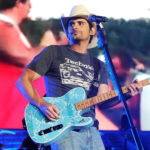Weezer frontman Rivers Cuomo famously stated, “Weezer isn’t stuck in roles, so we just do what we want to do, what makes us excited.” This ethos is perfectly embodied in their surprising and delightful cover of “Take On Me,” the iconic 1984 synth-pop masterpiece by Norwegian band A-Ha. Both versions of this song hold a unique charm. The original “Take On Me” was a marvel of its time, a precisely crafted three-and-a-half-minute slice of synth-laden melancholy. Weezer’s rendition, however, breathes new life into the track, transforming it into a surprisingly potent rock anthem. Even decades later, A-Ha’s original, driven by drum machines and sequenced keyboards, resonates with nearly a billion views on YouTube. Now, Weezer’s rock interpretation introduces it to a new generation while offering a fresh perspective for longtime fans. The story behind Weezer’s foray into 80s covers began unexpectedly in 2018 when a fan on Twitter playfully suggested they tackle Toto’s “Africa.” To everyone’s surprise, Weezer delivered, and their “Africa” cover became a massive hit, their first in ten years. This success seemingly opened the door to further explorations of 80s classics, leading to gems like their take on TLC’s “No Scrubs,” notably keeping the original female-perspective lyrics, a refreshing and humorous choice.
Listening to Weezer’s “Take On Me” prompts reflection, especially for those who experienced the original’s initial impact. Weezer’s cover is undeniably steeped in nostalgia, tapping into our collective musical past, a phenomenon that resonates with Simon Reynolds’ concept of retromania. Cover songs inherently trigger a comparative listening mode. When you encounter a cover of a beloved song like “Take On Me,” your mind immediately starts dissecting: What’s the same? What’s different? With a song as powerful as the original “Take On Me”, something more profound happens. The analytical comparison fades, and you become immersed in the music itself, experiencing a fascinating blend of the old and the new, unsure if you’re hearing the present through the lens of the past, or vice versa.
 Rivers Cuomo of Weezer performing live, bathed in stage lights, passionately singing into the microphone with his guitar slung low.
Rivers Cuomo of Weezer performing live, bathed in stage lights, passionately singing into the microphone with his guitar slung low.
What made A-Ha’s “Take On Me” so exceptional was its masterful understanding of pop songcraft. It’s a blueprint for pop perfection: concise verses acting solely as bridges to irresistibly catchy and repetitive choruses, executed with maximum efficiency. But “Take On Me” transcends mere structure; it’s a fusion of form and sound. Revisiting it today, it’s as if the song was conceived specifically for the synthesizers and drum machines that brought it to life. English producer Neill King, brought in to inject energy into A-Ha’s initial recordings, detailed in a Sound On Sound article the electronic arsenal he employed to achieve its signature sound:
“There was the Synclavier from which everything was sequenced. This was used as the drum machine; a mixture of synthesized and live samples courtesy of Tony Mansfield. The Synclavier was the first synth that grooved a little more following the first generation of drum machines. In terms of effects, there was a lot of reverb going around and we slammed the hell out of a Lexicon 224X and AMS RMX16. There was also an RMX15 for stereo delay. Classic ’80s stuff.”
The Neill King version achieved moderate success, but Warner Brothers, A-Ha’s record label, believed in its potential for greater heights. They enlisted producer Alan Tarney to reconstruct the track. Tarney’s studio staples included a Roland Juno 60, a LinnDrum machine (slightly dated by then), and a UMI MIDI sequencing computer – all instrumental in shaping the final version of “Take On Me.” As Tarney recounted in the same Sound On Sound piece:
“’Take On Me’ had a fairly standard Linn snare sound and I just remember compressing it quite heavily to get a very slappy feel. At the same time, while the quality of the Linn’s snare, toms and kick drum was quite good, its cymbal sounds were a bit crappy—no high end. So [A-Ha guitarist Pål Waaktaar] overdubbed real cymbals and possibly some hi‑hat in the studio, to add some clarity and get more of a live feel.”
Through this meticulous, layered production, “Take On Me” ascended to the top of the charts, propelled further by its groundbreaking and expensive music video. The video’s distinctive hand-drawn comic book animation became synonymous with the song, ensuring its constant rotation on MTV and embedding itself in pop culture history.
Comparing A-Ha’s original “Take On Me” with Weezer’s cover reveals key distinctions. Firstly, the original is in A major, while Weezer transposes it down a step, likely to accommodate Rivers Cuomo’s vocal range more comfortably. Production-wise, the original boasts a brighter, more vibrant sonic landscape compared to Weezer’s version, which leans towards a darker, almost muted tone, particularly in the drums, albeit with a heavier overall feel. This is somewhat paradoxical considering the original was recorded using warmer analog tape, unlike today’s typically computer-based DAWs. Furthermore, the original “Take On Me” is richer in textural nuance. Intricate programming details, such as the high-pitched, bee-like synth melody that dances across the stereo field and fades into reverb (around 2:02-2:08), or the drum machine fills that eerily mimic a live drummer, still sound remarkably fresh and inventive. Weezer partially compensates for this textural subtlety with beautifully crafted electric guitar arpeggios woven into the chorus, but overall, the original remains a testament to meticulous musical craftsmanship. This highlights a fundamental truth in music production: the tools—electronic or acoustic—are secondary to the artistry of arrangement and sonic architecture.
Another notable difference lies in vocal delivery. Rivers Cuomo arguably presents a vocally stronger performance than A-Ha’s Morten Harket. Harket’s voice possesses a sweet, almost choirboy-like quality, but closer listening reveals occasional unclear enunciation and a slight wavering in pitch and energy when sustaining falsetto notes. (Perhaps even those legendary 1980s Lexicon 224 reverbs had their limits). Cuomo’s voice sounds more forward, precise in its phrasing, and employs subtle, almost Michael Jackson-esque breathy, rhythmic glottal sounds around certain words. His vocal approach is nuanced and controlled. A third observation is the inherent adaptability of great songs. Weezer’s interpretation of “Take On Me” introduces two new structural elements: a half-time bridge featuring distorted electric guitars and crashing cymbals, and a brief, stripped-down interlude before the final chorus, showcasing just acoustic guitar and intimate vocals. The half-time section underscores the sophistication of A-Ha’s chord progressions, while the acoustic break highlights the enduring strength of Harket’s melody, even in its most skeletal form. A truly strong song transcends genre and artist, capable of being reinterpreted and reimagined, transferring its core energy across time and performers.
A fourth and final point of comparison is the extent to which electronic pop can be “rockified.” This, in turn, prompts the question: what happens when rock music undergoes a synth-pop (or electro R&B) makeover? This leads to a broader consideration of the permeable boundaries between pop music genres. Weezer retains the fundamental chord progressions, melody, and basic keyboard elements of A-Ha’s original but injects crunchy, distorted electric guitars, bass, and a full drum kit into the mix. As previously discussed on this blog regarding the “trickle-down” influence of EDM aesthetics on rock and pop, Weezer’s 80s covers now spark thoughts about the pervasive influence of rock conventions in shaping how we perceive and imagine other musical styles.
Weezer’s “Take On Me” cover gains further resonance through its music video, a charming narrative nested within another narrative. The simple story centers on a teenage Rivers Cuomo and his bandmates. With his mom out of the house, Cuomo grabs a slice of pizza and rallies his band to launch into their rendition of “Take On Me.” The video portrays Cuomo and his friends growing up in the 80s, immersed in synth-pop and rock. We see teenage Cuomo in his bedroom sketching a large “W” (for Weezer) in a notebook, dreaming of future stardom. This simple narrative unfolds within the visual world of A-Ha’s original “Take On Me” video, complete with its iconic hand-drawn animation. Weezer cleverly quotes this visual style, momentarily transforming teenage Cuomo and his band into comic strip characters. This visual quotation acts as a metaphor for Weezer’s cover version interweaving with A-Ha’s original recording. The overall effect is a layering of nostalgia, creating a blended sensation for viewers who are familiar with both versions. In the realm of music, the past and present are in constant dialogue. When the conditions are just right, certain songs, like “Take On Me,” find unexpected pathways to reignite our emotions and reconnect us with musical memories.


